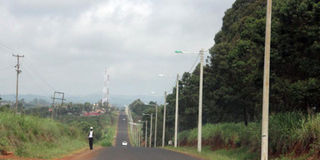Miracle of good roads and power

New street lights along Nyeri-Mathari road where thousands of faithful will be in a procession carrying the remains of Sister Irene Stefani on May 23, 2015 as they take them to Our Lady of Consolata catholic cathedral in Nyeri town. PHOTO | JOSEPH KANYI | NATION MEDIA GROUP
What you need to know:
- Gikondi Catholic Parish Chairman Daniel Njigua said in addition to the good roads, the village has been connected to the main power grid.
- The priests were also unable to access the Gikondi Parish due to impassable roads.
- The two said Sister Irene’s remains had been buried seven feet underground due to the bubonic plague which had caused her death in 1930 after she contracted it from a patient she was nursing at Gikondi village.
Gikondi village has in the past few weeks been catapulted to international limelight, thanks to the beatification of Sr Irene Stefani.
The local Catholic Church perched at the apex of one of the ridges in Mukuruwe-ini sub-county in Nyeri has seen many visitors. The once bumpy and dusty roads that snake through canopies have now been opened.
When Saturday Nation visited this week, villagers were very positive about the awaited ceremony.
Gikondi Catholic Parish Chairman Daniel Njigua said in addition to the good roads, the village has been connected to the main power grid.
“The roads are now being rehabilitated and we can see the fruits of Sister Irene. Previously, the roads were impassable and as we speak all the roads within this location, in the villages of Karindi, Nyakahuho, Gathiriti, Muthuthi-ini, Kibutia, Kaharo, Karaba and Kabata are now being rehabilitated,” he said.
The priests were also unable to access the Gikondi Parish due to impassable roads.
“The residents are happy about this and the people’s mood is very positive towards this beatification event of Sister Irene including those from other denominations who want to join the Catholic faithful in celebrating Nyaatha’s beatification,” he said. Beatification is regarded as the third of four parts in the canonisation process within the Roman Catholic Church, as the church waits for the person’s sainthood.
And, it is until recently when the ceremony started to be held in the diocese where the person to be beatified lived and died. Previously, it took place only at the Vatican.
Today, as Dar-es-Salaam Archbishop Polycarp Cardinal Pengo reads out the apostolic letter of beatification on behalf of Pope Francis, and as John Cardinal Njue presides at the celebration of Holy Mass, the about 1,100 Catholics in Gikondi parish hope that some of Sr Irene’s relics will be preserved in their church because she was part of them.
Sister Irene Stefani had been buried deeper than the normal six feet because the bubonic disease she succumbed to did not have a known cure.
Rosemary Wangui, 52, from Gikondi, was among the people who witnessed the exhumation of Sr Irene Stefani in 1995 from Mathari Mission cemetery to the chapel where her remains are being preserved.
In 1995, the Holy See issued a cause for beatification and the Pope declared Sister Irene a servant of God.
Ms Wangui together with 73-year-old colleague Monica Wahito speaking to Saturday Nation yesterday said they were informed the exhumation by their local parish priest and decided to travel to Mathari to witness it.
The two said Sister Irene’s remains had been buried seven feet underground due to the bubonic plague which had caused her death in 1930 after she contracted it from a patient she was nursing at Gikondi village.
“Those who were exhuming the body had worn protective gear and they initially dug the usual six feet, only to realise she had been buried deeper than expected”, Ms Wangui said.
Her colleague Ms Wahito added, “The casket was spotted after going farther down by another one foot. The cover was removed and I saw her skeleton and her boots exactly the way her legs had been positioned inside the casket.”
The exhumation team was led by a doctor who directed how the bones were to be arranged in a new box which was sealed and placed inside a chapel in Mathari Mission Centre.
It is also at that time when the doctor realised that instead of her brain having decomposed, it had compressed and was still intact within the skull, something he termed as unusual.
“It was a very extraordinary event and everybody present wanted to touch her remains,” said Ms Wahito.





